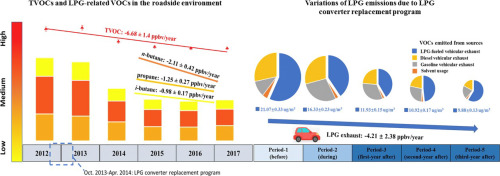Science of the Total Environment ( IF 8.2 ) Pub Date : 2018-08-17 , DOI: 10.1016/j.scitotenv.2018.08.191 Dawen Yao , Xiaopu Lyu , Frank Murray , Lidia Morawska , Wang Yu , Jiaying Wang , Hai Guo

|
To mitigate the concentrations of air pollutants in the atmosphere, an intervention program of replacing the converters of liquefied petroleum gas (LPG) fueled vehicles was implemented by the Hong Kong government between October 2013 and April 2014. Data of ambient volatile organic compounds (VOCs) and other trace gases continuously monitored from September 2012 to April 2017 at a roadside site were used to evaluate the continuous effectiveness of the replaced catalytic converters on the reduction of air pollutants. The measurement data showed that LPG-related VOCs (propane and n/i-butanes) and several trace gases (CO, NO and NO2) decreased significantly from before to after the program (p < 0.01). To further assess the efficiency of the program, five periods covering before the program, during the program, 1st year after the program, 2nd year after the program and 3rd year after the program were categorized. The values of propane and n/i-butanes decreased from Period-1 (before the program) to Period-2 (during the program), and from Period-2 to Periods 3–5 (after the program) (p < 0.01). In addition, the reduction rates of propane and n/i-butanes remained high and constant in Periods 3–5, suggesting that either had the vehicle owners themselves routinely replaced the converters at suitable interval afterwards, or were their vehicles caught by a remote sensing program checking excessive emissions. Source apportionment analysis indicated that LPG-fueled vehicular emissions were the top contributor to ambient VOCs in the roadside environment while the VOCs emitted from LPG-fueled vehicles indeed decreased at a rate of 4.21 ± 2.38 ppbv/year (average ± 95% confidence interval) from Period-1 to Period-5 (p < 0.01). Furthermore, the photochemical box model simulations revealed that the net negative contribution of VOCs and NOx emitted from LPG-fueled vehicles to O3 production strengthened at a rate of 1.9 × 10−2 pptv/day from Period-1 to Period-5 (p < 0.01). The findings proved the continuous effectiveness of the intervention program, and are of help to future control strategies in Hong Kong.






























 京公网安备 11010802027423号
京公网安备 11010802027423号